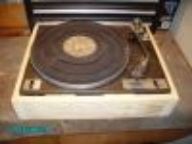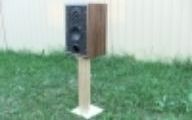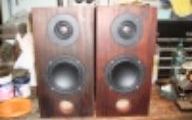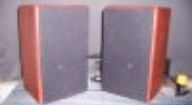
WORTHINGTON'S WORKSHOP
High Fidelity - Main Page
|
|
Crossover Frequencies Audio information is contained within the limits of 800Hz to 3.4kHz - the bandwidth of your home telephone system. A loudspeaker system would be best designed to convey this band with minimal distortion, and having penetration of response to higher and lower frequencies to fill out the sound. Ideally a loudspeaker should have a midrange driver that covers the whole of the midrange, crossing over to a woofer below 800Hz and to a tweeter above 3,400Hz. These limits create the art in loudspeaker design. Surprisingly, quite a few 'High_Fidelity' loudspeakers do not meet this criterion. The British love their two way systems that cross over drivers in the centre of this band, and the Americans will drive the bass units on their three way systems up into this area - this is what is responsible for the 'English' and the 'West Coast Sound'. The 'Australian' sound is regarded to be between the two - the high end local manufacturers have a prediliction for 6dB/octave crossovers and high spec drivers. I don't adhere this concept because of the bandwidth criteria. Driver Operating Frequencies The important selection of drivers in a loudspeaker system is to have the drivers not exceed their bandwidth capabilities. This is determined by the Thiele/Small parameters (Fo, Qm, Qe and Vas) to determine the bass response; and the cone diameter to determine the maximum frequency allowable on the cone before non piston modes of operation cause the cone to beak up. Cone break up can be standing waves across the cone, umbrella surface-like distortion or having the circular cone distort into an oval shape. A rule of thumb is to limit the drive frequency to 160kHz / mm of cone diameter. This gives a maximum of 533 Hz for a 12" (300mm) woofer and 1.6kHz for a 4" (100mm) midrange driver. Try and get the drivers to overlap the crossover frequencies by a one octave higher and lower extension ie, to cross over at 800 Hz and 3,4 kHz, the midrange would ideally have to have a resonance below 400Hz and a cone breakup above 6,8 kHz. This top end criteria is somewhat difficult, but the cone surface may be modified to extend the breakup point - see below. Doping The Cones Investigation of a next door neighbours JVC 3 way bookshelf revealed improvement when the bass and midrange driver cones were doped with Aquadhere wood glue. The process is to wet the surface of the cone with a misted spray from a water filled detergent spray bottle, then paint the cone evenly with a thimble full of PVA glue. The cone is then set in front of a room heater blower for a couple of minutes to dry the glue. Be sure keep the cones at least 300 mm away from the heat, as the glue could bubble. Repeat the process if required after a listening test. I doped the midrange cones on the Bookshelf speaker in this manner, to great effect. The speakers are much more musical and detailed, even bettering a set of Jamo bookshelves in an A-B comparison. The reason for the improvement is that the stiffer cones now have a cone breakup that occurs at higher frequencies, which is reduced by the rolloff of the crossover network. This process would seem to be one of the most effective methods of improving the sound of inexpensive paper coned drivers. Driver Power and Efficiency Other parameters to match will be the power handling and the efficiency. In a three way system, generally account for 70% of the power in the woofer, 20% in the midrange and 10% in the tweeter. This means a 100 watt system can be handled by a 70 watt woofer, a 20 watt midrange and a 10 watt tweeter. The efficiency of the woofer will be the limit of the whole system. Expect to lose 0.5 to 1.0 dB in the crossover network for each driver - this can be calculated. Rate the midrange and tweeter efficiency above that of the bass driver and then use attenuators to equalise the sound levels. Note also that larger drivers have higher mass cones and are therefore slower in transient response. Crossover Network For critical minimalisation of the audability of cone resonances, the response of the crossover should be 24dB/octave (fourth order) to make use of real world midranges and tweeters. A compromise would be to use a 12dB/octave (second order) crossover on the less critical bass to midrange crossover. The 12dB/octave network also has less loss for the woofer. Linkwitz networks are preferable to Butterworth networks due to a wider, flatter off centre response - which supports equalisation of the direct and ambient sound fields from the speaker. I would expect to end up with a system using 8" (200mm) or less bass driver(s) crossing over at 400 Hz using a 12dB/octave network, a 3" (75mm) cone midrange and a 1" (25mm) dome tweeter crossed over at 3.5kHz using a 24dB/octave Linkwitz network. Note that the midrange / tweeter crossover is still not ideal. Try and use hand wound coils as they can be designed to give half the resistance of the coils available off the shelf in shops. Also use low leakage Metallised Polypropylene capacitors as these definitely affect the sound of the speakers. Mount the network on a Jaycar Crossover PCB - part No CX-2605 - for the two way. The three-way board - part No CX-2606 - does not have enough room for the mass of components, and the best idea is to break up the crossover onto two two-way boards. Other Crossover Factors You can go the whole hog in crossover networks and design a network that equalises speaker impedence and resonances, plus match impedences and levels. I have also had success with drivers using a single crossover capacitor. The small bookshelf I designed uses a 12dB/octave Linkwitz with voice coil inductance correction only, and it sounds quite accurate. Use good cable for the internal wiring and the external connecting cable. I found an oxygen free copper cable sold by Dick Smith Electronics as Digitor W2803 and by Bunnings as the same 20 metres of 16AWG, for $40 a roll. This will definitely make an audible difference to your speakers - money well spent. Cabinet Design The cabinet must be a size dictated by the Thiel/Small parameters for either an Acoustic Suspension or Bass Reflex design. The Acoustic Suspension design has a 12dB/octave rolloff below resonance, giving a better transient response. The resonance is usually half an octave higher, and is slightly less efficient, than a similar Bass Reflex. It is less critical of build dimensions. The Bass Reflex is more efficient and smaller dimensioned for bass drivers, especially subwoofers. Design of the port is also critical. Mount the midrange driver at ear height when seated on your favourite listening chair. Keep the front width of the cabinet as small as possible, to take the point at which edge diffraction occurs up to the highest frequencies. Rounding the edges to minimise diffraction is especially critical for time delayed loudspeakers. Applying a felt mat around the midrange and tweeter, and mounting the drivers flush with the front surface of the cabinet also assists in reducing diffraction effects. Cabinet Structure Build the cabinet from particle board, using 12mm for smaller cabinets and 19mm for bigger cabinets, supported by a chassis of 38mm * 19mm bracing using high density timber - not pine. The bracing should divide the areas of the walls into non equal size triangular sections to break up resonances. Bracing across to opposite panels is also effective. This makes for a neutral cabinet that will pass the 'knuckle knock' test for panel deadness. You will be aware the speaker cabinet is extremely heavy, which precludes the homemaker from shifting it as a piece of furniture. The cabinet internal surfaces should be damped with a 19mm layer of high density rubber foam, and then a layer of insulwool to prevent panel resonance, assist in the absortion of standing waves, and prevent reflection of sound from the back of the cabinet through the cone. Aesthetic consideration should be given to finishing the cabinet in a nice veneer, or some sort of painted finish, and mount the drivers on carpet piercing spikes to stabilise the speaker when driving bass. Use the grill cloth available from Jaycar mounted on a 6mm thin piece of particle board. Mount the grille board using Jaycar grille mounting plugs. Other Considerations A computer is useful for calculating the speaker parameters as I spent some weeks on a calculator designing the crossover for the 'Sentinel' speaker. You will also be made welcome at Bunnings as you purchase tools. I would recommend at least a circular saw for cutting panels, a router to cut circles and trim edges, a battery powered hand held drill and a set of 1200mm sash cramps for panel assembly. More goodies can be accumulated as circumstances dictate. Early Days I became interested the first day I arrived in Sydney for employment during 1972. Dad had parked outside Instrol HiFi in York street, and I had my first glimpse of what was to become a lifetime obsession. After a few years work scrimping and saving I finally bought a Rotel 310 amplifier, a Dual 1214 turntable, a Marlux 2000 cassette deck and had dad build a set of Magnavox 8-30 loudspeakers. Today none of this would even be remotely considered High_Fidelity, but in those early days it gave me access to music. Eventually steps were made to improve this system. The First Upgrade to the Loungroom system The Rotel 310 amplifier was replaced with a 35 watt/channel Sansui AU-217, the turntable with a floating platter ERA type 3 (bought second hand for $100 and lugged from Quantum HiFi in Hobart, Tasmania), the cassette deck with a Thorn DCR-1 (an OEM model from Nakamichi) and the speakers replaced with the Sentinel models that I built. This setup lasted many years, until the advent of CD's. A successful attempt was made to build an low power amplifier, which is described in the link above. It is based on a modified Playmaster (Electronics Australia) design rated at only 13.7 watts/ch and 20Hz-37kHz response. It is far more musical than a lot of bigger amps. The various Low Power Amplifier Models There are four models of this amplifier in existence. One is a quality commercial looking unit that I keep for a second hi-fi system. The second was built for dad, and housed in a Pioneer A-500 chassis, with dual cassette switching as a feature. My sister inherited it and promptly blew it up after shorting the speaker leads. I reclaimed and repaired it, eventually selling it to a previous next door neighbour. The third is a chassis-less PCB that I attach to a power supply to test speakers in the workshop, and the fourth is a mono only amp used for speaker impedence testing. Turntables I was given a Bang and Olufsen turntable, which I used to convert some of my LP's to CD's. The LP collection was then sold off for about $300 to a couple of vintage record stores in Penrith. I don't miss them as the replacement CD's are available for about $10 each. The older turntables were also disposed of - the Dual because of excessive rumble, and the ERA due to dad dropping a wrench on the unique arm suspension system. The Era had a decent Rega 100 arm mounted as a fixture on the chassis and was then sold to a work mate. Listening to my remaining LP's shows how much noise I used to put up with. Scrapping More Old Gear An Alpage AL-300 three head cassette deck was given to me by a work mate, as he considered the head too expensive to replace. I did the job myself for $115.00. I have now worn out the head a second time. The deck began playing up with recording levels and speed variation, so it was disposed of. My collection of cassettes are now no longer used. The Rotel amp and the Marlux cassette deck were decrepit, and were disassembled for parts and scrapped. After 25 years use the Sentinels were disassembled, with the forlorn and flaking cabinets broken up. Music In The House In the bedroom a Realistic STA-460 AM/FM Stereo Receiver (22 watts/chan) is used to drive the small pair of home made bookshelf speakers - also described in a link above. Surprisingly, this sounds more open and detailed than the previous Lounge System. In the workshop the Low Powered Amplifier is used in the speaker test setup, along with a fantastic old analog Sony AM/FM tuner and a surprisingly good Pye CD player extracted from a mates 3 in 1 system. I always use CD players - even cheap models - for audio reproduction, as the audio stages of DVD players do not seem to be up to Hi-Fi standards. Several sets of speakers are under development, including modifications to a set of muddy sounding Jaycar JC-25 speakers which were found to have inverted connections to the tweeters. I rebuilt the Sansui amplifier by replacing the electrolytic capacitors. This stopped the crackling noises that occasionally interrupted the music. It sounds a lot better now and is used in the main loungeroom system, as is the Bang & Olufsen turntable, a Sony CD player and a small set of Jamo Studio 120 bookshelf speakers on stands. All of this is set up, as per pictures of the 'Oscar' speaker, in an Ikea hifi cabinet. The Jamos have now been replaced by the HP Standmount speakers. How about doing up some second hand gear? Due to friends knowing of my interest in HiFi, I get given old pieces of equipment as gifts. For instance I have recently been given an Akai stereo system and a Rolls stereo system. The Akai had a working amp and tuner plus a turntable requiring a stylus and glueing of the headshell mount to the arm. I ordered two styli from American eBay for $AUS25. The cassette deck was beyond redemption and met its fate in the garbage bin. Apart from a set of speakers (easily built) and a CD player (easily purchased), this is the basis of a complete HiFi system. The Rolls system was a combined amp/turntable with a pair of Magnavox (Aust) 8WR based speakers using twin 15ohm woofers. The amp was trashed due to mediaeval germanium transistor technology. The speakers were disassembled as the cabinets will be used for a better system. The turntable was a Dual 1210 automatic rim drive which plays 33, 45 and 78rpm records. It has been setup for correct tracking, lubricated and cleaned. With the ceramic stylus it may be suitable for someone to transcribe 78s onto CD. Most of the equipment I have, as you have probably guessed, is well used, reasonably old and/or obtained second hand. I enjoy tweaking the gear I have, to improve performance and extend its life. Equipment I have modified, repaired or built has included several amplifiers, many loudspeakers, two turntables with replaced arms, several tweaked cassette decks and an aligned tuner. Why not attempt a HiFi project yourself - a little knowledge of electronics, woodwork or acoustics can go a long way. If you must spend your hard earned dollars on new equipment...
|








